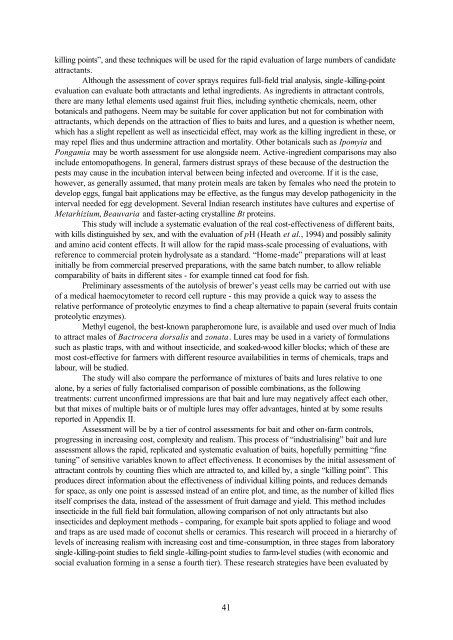“Key Informant Survey” of Production, Value, Losses and ... - DfID
“Key Informant Survey” of Production, Value, Losses and ... - DfID
“Key Informant Survey” of Production, Value, Losses and ... - DfID
You also want an ePaper? Increase the reach of your titles
YUMPU automatically turns print PDFs into web optimized ePapers that Google loves.
killing points”, <strong>and</strong> these techniques will be used for the rapid evaluation <strong>of</strong> large numbers <strong>of</strong> c<strong>and</strong>idate<br />
attractants.<br />
Although the assessment <strong>of</strong> cover sprays requires full-field trial analysis, single-killing-point<br />
evaluation can evaluate both attractants <strong>and</strong> lethal ingredients. As ingredients in attractant controls,<br />
there are many lethal elements used against fruit flies, including synthetic chemicals, neem, other<br />
botanicals <strong>and</strong> pathogens. Neem may be suitable for cover application but not for combination with<br />
attractants, which depends on the attraction <strong>of</strong> flies to baits <strong>and</strong> lures, <strong>and</strong> a question is whether neem,<br />
which has a slight repellent as well as insecticidal effect, may work as the killing ingredient in these, or<br />
may repel flies <strong>and</strong> thus undermine attraction <strong>and</strong> mortality. Other botanicals such as Ipomyia <strong>and</strong><br />
Pongamia may be worth assessment for use alongside neem. Active-ingredient comparisons may also<br />
include entomopathogens. In general, farmers distrust sprays <strong>of</strong> these because <strong>of</strong> the destruction the<br />
pests may cause in the incubation interval between being infected <strong>and</strong> overcome. If it is the case,<br />
however, as generally assumed, that many protein meals are taken by females who need the protein to<br />
develop eggs, fungal bait applications may be effective, as the fungus may develop pathogenicity in the<br />
interval needed for egg development. Several Indian research institutes have cultures <strong>and</strong> expertise <strong>of</strong><br />
Metarhizium, Beauvaria <strong>and</strong> faster-acting crystalline Bt proteins.<br />
This study will include a systematic evaluation <strong>of</strong> the real cost-effectiveness <strong>of</strong> different baits,<br />
with kills distinguished by sex, <strong>and</strong> with the evaluation <strong>of</strong> pH (Heath et al., 1994) <strong>and</strong> possibly salinity<br />
<strong>and</strong> amino acid content effects. It will allow for the rapid mass-scale processing <strong>of</strong> evaluations, with<br />
reference to commercial protein hydrolysate as a st<strong>and</strong>ard. “Home-made” preparations will at least<br />
initially be from commercial preserved preparations, with the same batch number, to allow reliable<br />
comparability <strong>of</strong> baits in different sites - for example tinned cat food for fish.<br />
Preliminary assessments <strong>of</strong> the autolysis <strong>of</strong> brewer’s yeast cells may be carried out with use<br />
<strong>of</strong> a medical haemocytometer to record cell rupture - this may provide a quick way to assess the<br />
relative performance <strong>of</strong> proteolytic enzymes to find a cheap alternative to papain (several fruits contain<br />
proteolytic enzymes).<br />
Methyl eugenol, the best-known parapheromone lure, is available <strong>and</strong> used over much <strong>of</strong> India<br />
to attract males <strong>of</strong> Bactrocera dorsalis <strong>and</strong> zonata. Lures may be used in a variety <strong>of</strong> formulations<br />
such as plastic traps, with <strong>and</strong> without insecticide, <strong>and</strong> soaked-wood killer blocks; which <strong>of</strong> these are<br />
most cost-effective for farmers with different resource availabilities in terms <strong>of</strong> chemicals, traps <strong>and</strong><br />
labour, will be studied.<br />
The study will also compare the performance <strong>of</strong> mixtures <strong>of</strong> baits <strong>and</strong> lures relative to one<br />
alone, by a series <strong>of</strong> fully factorialised comparison <strong>of</strong> possible combinations, as the following<br />
treatments: current unconfirmed impressions are that bait <strong>and</strong> lure may negatively affect each other,<br />
but that mixes <strong>of</strong> multiple baits or <strong>of</strong> multiple lures may <strong>of</strong>fer advantages, hinted at by some results<br />
reported in Appendix II.<br />
Assessment will be by a tier <strong>of</strong> control assessments for bait <strong>and</strong> other on-farm controls,<br />
progressing in increasing cost, complexity <strong>and</strong> realism. This process <strong>of</strong> “industrialising” bait <strong>and</strong> lure<br />
assessment allows the rapid, replicated <strong>and</strong> systematic evaluation <strong>of</strong> baits, hopefully permitting “fine<br />
tuning” <strong>of</strong> sensitive variables known to affect effectiveness. It economises by the initial assessment <strong>of</strong><br />
attractant controls by counting flies which are attracted to, <strong>and</strong> killed by, a single “killing point”. This<br />
produces direct information about the effectiveness <strong>of</strong> individual killing points, <strong>and</strong> reduces dem<strong>and</strong>s<br />
for space, as only one point is assessed instead <strong>of</strong> an entire plot, <strong>and</strong> time, as the number <strong>of</strong> killed flies<br />
itself comprises the data, instead <strong>of</strong> the assessment <strong>of</strong> fruit damage <strong>and</strong> yield. This method includes<br />
insecticide in the full field bait formulation, allowing comparison <strong>of</strong> not only attractants but also<br />
insecticides <strong>and</strong> deployment methods - comparing, for example bait spots applied to foliage <strong>and</strong> wood<br />
<strong>and</strong> traps as are used made <strong>of</strong> coconut shells or ceramics. This research will proceed in a hierarchy <strong>of</strong><br />
levels <strong>of</strong> increasing realism with increasing cost <strong>and</strong> time-consumption, in three stages from laboratory<br />
single-killing-point studies to field single-killing-point studies to farm-level studies (with economic <strong>and</strong><br />
social evaluation forming in a sense a fourth tier). These research strategies have been evaluated by<br />
41

















